Alright, here’s what you need to know. Both the Marcato and Imperia are excellent pasta makers. I recommend both of them!
The Marcato Atlas 150 is the best choice if you plan on getting more and more comfortable with making homemade pasta over time. Only plan on making pasta every now and then? The Imperia 150 offers great quality, is often cheaper but misses the attachment upgrades Marcato offers.
The Marcato 150 Atlas is the winner
If you’re looking for a high quality pasta maker, your eyes are probably set on either the Marcato Atlas 150 or the Imperia 150. Both are great picks, but the last 2 years the Marcato has become the clear winner. Why? The Marcato has a better build quality and has more attachments. With Imperia price-matching the more expensive Marcato, I see little reason to recommend the Imperia.
Marcato Atlas 150
The best manual pasta maker that comes with two attachments and can make longer pasta such as spaghetti, fettuccine and lasagne sheets out of the box. High quality, made in Italy and available in multiple colors.
Both these machines are excellent pasta rollers, but there are some differences between them that you should know about. In this pasta roller comparison we will look at the differences, reviewing both what we like and dislike about these pasta makers. We will compare the Marcato Atlas versus the Imperia, and at the end of this review you will know which pasta roller suits you the best.
If you want to read the single reviews first on both pasta rollers, here is the link to the Marcato Atlas 150 pasta maker review and the CucinaPro Imperia 150 Pasta Roller review.
Comparison Marcato VS Imperia
Marcato Atlas 150
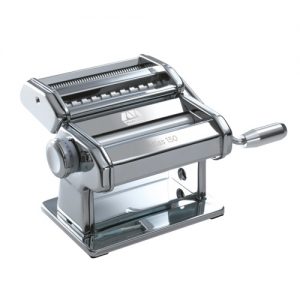
0.6 mm to 4.8mm rollers
9 different thickness settings
Motor attachment available
Fettuccine, spaghetti cutter & pasta sheet roller
17 total attachments available
Great build quality, very little complaints about
Available in 9 colors
Plastic hand crank
10 years warranty
Score 5/5
Imperia 150
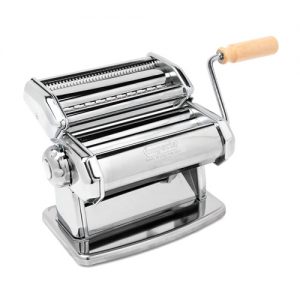
0.9mm to 4.3mm rollers
7 different thickness settings
Motor attachment available
Fettuccine, spaghetti cutter & pasta sheet roller
6 total attachments available
Good build quality, but some complaints about plastic parts
Available in one color
Wooden hand crank
1 year warranty
Score 4/5
Marcato and Imperia: comparing the brands
Both the Marcato Atlas 150 and the Imperia 150 are from an original and high quality pasta roller brand. Both manufacture their pasta rollers in Italy and have been at in since the early 1900’s. That are quite some years worth of experience building, improving and designing these machines.
Roundup: Both companies know how to manufacture high quality pasta makers and they are going for the long run. This means that both companies will most likely still be around in a few years, so you don’t need to worry about warranty if you would experience a problem with the pasta machines.
Comparing the rollers and cutters
Both models offer the same basic functionalities, there aren’t many differences to spot when you put the two side by side.
Both pasta makers feature a 6-inch wide roller, which means that the maximum width of the dough sheets are 6 inches. This width is perfect for when you are making homemade pasta, as it will provide enough pasta for you and your family (and friends of course). That being said, the width of 6 inch is an almost universal standard on all consumer pasta machines.
Marcato does offer the Atlas 180 model, but none of the 150 attachment will work on this machine. It’s nice for the bigger sheets, but you’ll miss out on using all of the attachments that are designed for the 150.
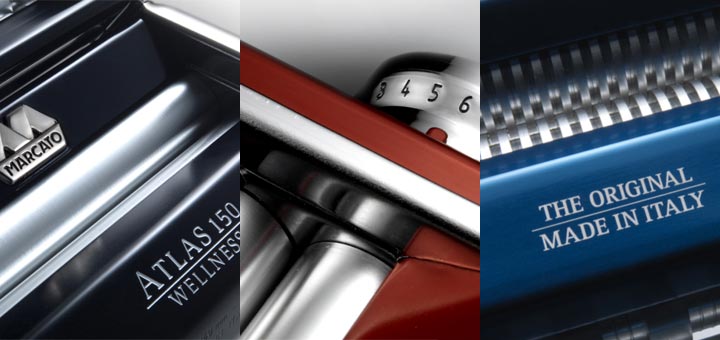
Both machines are made from chrome plated stainless steel, which is easy to dust off but isn’t what you’d call water resistant. Stainless steel doesn’t mean you can wash or clean it with water. Your machine will quickly start rusting, so please use a brush and a toothpick when cleaning either the Imperia or Marcato.
The Marcato Atlas 150 is equipped with Wellness rollers which are made of anodized aluminum. Anodized aluminum is twice as hard as stainless steel, making the chance of metal particles less likely with rollers made from anodized aluminum. As Marcato has patented this technology, there are no other pasta rollers that have this same feature. If you and your family try to avoid aluminum with cooking altogether,
Every high quality pasta roller should be able to roll pasta into various thicknesses, and every pasta maker has different thickness settings. While the Marcato has 9 different thickness settings, the Imperia has 7. This doesn’t necessarily make the Marcato better, but the Marcato can make a bit thinner pasta which is nice for some types of pasta.
Roundup: If we look at the technical specifications of the two pasta machines, the Marcato is the better choice. The Wellness rollers that keep out any harmful metal out of your pasta is a big plus compared to the Imperia, as health is very important in our food.
The 9 different thickness settings of the Marcato are a plus, yes, but we wouldn’t say that this is a deal breaker for the Imperia.
Extra pasta shape attachments for both machines
One of the most important aspects of any pasta maker are the attachments, not only what types of pasta they can make but also how well your homemade pasta is when using these attachments. If we compare the Marcato attachments with those of the Imperia, we don’t spot any difference. With both machines you get two attachments: one for fettuccine and one for spaghetti (and vermicelli if you use a very small thickness during the rolling process).
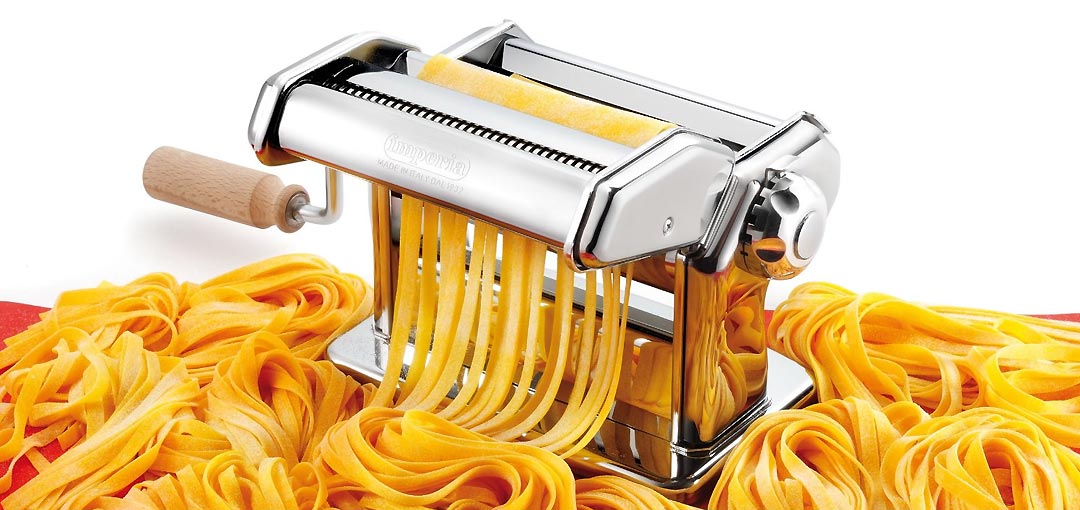
Testing the attachments with flour & dough
Without any big differences, it’s time to compare the models and put them to the test. I chose to make an egg pasta and used a 50/50 with semolina and type 00 pasta flour. After you’ve decided for either the Marcato or Imperia, you should check read my guide on the best pasta flour to get you started.
Cutting in half the dough I was sure the dough used with both machines was the same. I just really wanted to see if there were any major differences between the cutters and rollers.
Using the rollers
Both the Imperia and Marcato had no problems with rolling the dough to my desired thickness. Marcato has 9 thickness settings and the Imperia uses 7. Not a big difference at all, you’ll figure out your desired thickness soon enough. More or less isn’t better, both pasta makers offer enough control.
The result was pretty much the same – pretty, thin sheets of pasta. Really, as long as your dough is great most pasta rollers do a decent job.
Using the cutters for spaghetti & fettuccine
Beside the roller and the two cutters, there are more attachments available for the two pasta makers. The Marcato has a total of 9 different attachments available for long types of pasta, and Imperia sells up to 6 different attachments for the Imperia.
Amazing. That is what we said when we looked at out fresh fettuccine and spaghetti. Not one single strand of either the spaghetti or fettuccine was sticking together! Both pasta machines did a perfect job, the pasta was great and there was no dough stuck in either roller or the cutters. Ofcourse, the pasta dough plays a huge role.
Roundup: Both machines rollers and cutters work great. Marcato offers a lot more available attachments, where Imperia’s collection of attachments is a bit lacking. They are both perfect and make delicious homemade pasta. If you want to expand your collection of attachments, choose the Marcato.
Design
One thing can be said for sure: if we are looking at the design of the pasta rollers, the Marcato Atlas 150 Wellness would definitely be the winner of the two. Featuring a classic and high-class design, you get the feeling you are looking at a high quality product. From the beautiful beveled logo to the nine different colors that the Marcato is available in: it just looks and definitely feels right.
Nine different colors? That’s right! With the ongoing success of the Marcato Atlas 150 series, Marcato decided to make the model available in nine different colors: copper, red, heavenly blue, gold, pink, black, blue, green and of course the standard chromed edition.
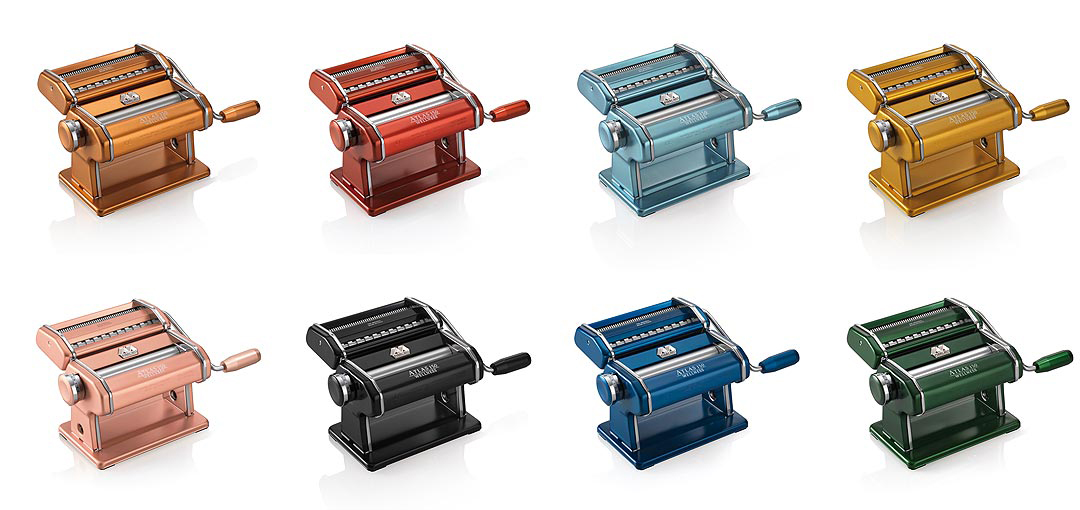
The Imperia on the other hand has a very basic design, as the Imperia looks very comparable with all the other pasta rollers out there on the market. The design doesn’t reflect the quality of the machine and the Imperia definitely looks good in your kitchen. Especially the wooden handle is a lovely touch and it lovely on the shiny Imperia.
Roundup: If you want a pasta machine that is more colorful, the choice should be easy: Marcato has proven that pasta makers shouldn’t look like boring kitchen appliances and can actually be really stylish.
Warranty
Marcato offers 10 years of warranty, whereas Imperia models only come with a 1 year warranty. This is a significant difference between the two manufacturers and is alone one of the main reasons that I personally use a Marcato. Since a pasta maker is essentially a machine with gears and other mechanisms, they can break! So it is important to look at the warranty.
The Imperia comes with a one-year manufacturer’s warranty, and we are just going to be honest here: this isn’t a very long period of time, especially compared to the 10 year warranty Marcato offers.
Marcato offers an almost unique period of warranty, a total of 10 years. The Marcato Atlas 150 has a standard warranty of 2 years, but Marcato adds another 8 years which sums up to a total amount of 10 years. This demonstrates the company’s trust in the product, and it is definitely a good thought to have in the back of your head.
Roundup: Hands down, the Marcato is the absolute winner if we are comparing the warranty. With a total of 10 years versus the 1 year that the Imperia offers, it is not even close.
Optional pasta motor attachment
The two pasta rollers can be turned into real motorized pasta machines with their respective motor attachments. The pasta machine motor for the Marcato and Imperia are both made of plastic and steel, which doesn’t feel too sturdy, rather flimsy honestly. It still works after all these years, but I’ve always used it with caution.
That being said, the motor attachment works great on the Marcato Atlas 150 and my 180 model as well. It has two different speeds to choose from and it allows me to use both of my hands.
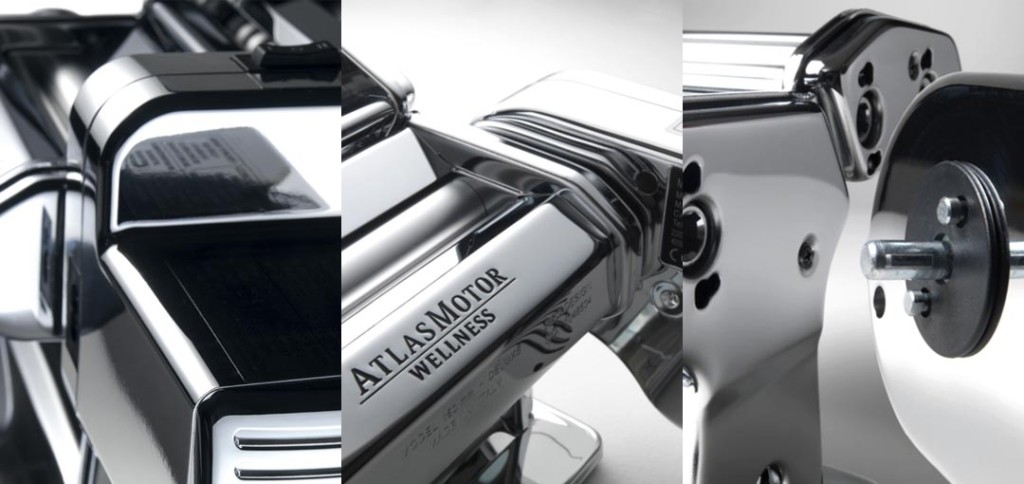
While we tested the motor attachment for the Marcato, I didn’t test it for the Imperia. Comparing the specifications of the two attachments, there doesn’t seem to be a difference, and I suspect that they both work just as well.
Roundup: Both the Marcato and the Imperia have their own first-party compatibile motors that can motorize the machine. You don’t need a special model of either machine to use the motor.
Pricing of both machines
If you want a high quality machine, but would like to save where possible, the Imperia is a perfectly good choice. Just remember there are less attachments available, but if you don’t care about these attachments, and are just looking for a flat pasta roller then the Imperia is a great, authentic Italian machine that offers solid value for money.
But, if you’re looking for the best, just go for the Marcato – it’s a no brainer. With plenty of options available when it comes to extra attachments, It’s simply the best manual pasta maker available right now, but you just have to pay a little bit extra for that.
Overall Winner – The Marcato Atlas 150
Both are great models. If both machines were at the same price point, I can’t see a reason to buy the Imperia over the Marcato. But with the Imperia priced lower, it does offer a solid choice as a budget high quality pasta maker.
With all the positives for the Marcato, it definitely is the winner of the two for me. There’s a total 10 years of warranty, it has a premium design and there are plenty of optional upgrades and attachments (and even the motorized upgrade that works perfectly). For a more in-depth look read my full Marcato 150 Review.
Video showing the Marcato Atlas 150 in use
If you want a good look at the Marcato, watch the video below to see how great it looks and how easy it is to operate.

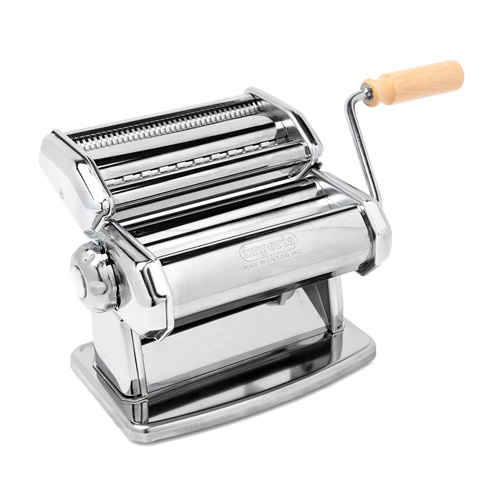
I have a light blue Marcato Wellness, bought about 17 years ago. The rollers broke down two years ago and I could not repair them – but at that time they had been processing probably above 100 kg of pasta dough.
Now I have bought a new (chrome color) Welness model. Compared to th eolder it has plastic parts underneath the cutters to seperate the cut sheets from the cutters. Also the cutters are for fettuchine and tagliatelle. The old model had a real nice spaghetti cutter in place of the tagliatelle, and a metal dough seperation was done by metal parts.
I also bought the AtlasMotor with the new one. It is made of chomelooking plastic; to keep weight down I expect; it works well though, but it is very VERY noisy. I’d be interested in Imperia if their motor is more silent; on th eother hand, the Imperia motor requires a plastic piece to be attached. The Marcato motor doesn’t – it has a more clever form of attachement.
I’ve been using my mother’s 1967 Imperia for 20 years. It’s 2 years older than I am but unlike me it’s lcosmetically and mechanically like new.
If I can comment about the warranty, I have an Imperia …of my granma! So is >50 years old and in perfect condition.
On the other side, I am looking for a Bigoli attachement, but not available for Imperia, other than a very expensive standing alone Torchio (bronze). Even if indeed “bigoli al torchio” are the best, the price tag (>300bucks) is not for me. I guess I will be making very thick spaghetti…
My feeling is that Imperia is missing out a bit in terms of market niches (little metal particle release seems more advertisment and are inconsequential), and that is a pity (maybe cheaper? or just old style managers?).
any help for a cheap torchio?
cheers,
Fabrizio
I recently bought the bigoli attachment for my 30 year old Marcato Atlas. It works flawlessly, and a plus is that it also makes passable Shanghai noodles for a Chinese stir fry. They are almost identical to the Shanghai noodles I’ve been buying in China Town in Montreal, for decades.
At the same time, while Bigoli noodles are made with the #2 thickness on the Atlas (very thick), the #3 or #4 thickness yields something approaching Linguine noodles. Bonus. I’ve been making linguine for days now.
i bought my Imperia in 1985 !!! maybe Cucina Pro is new, Imperia certainly isn’t
the build quality on the imperia is just awesome, the plates are thicker than the marcato, it’s hard to see why you think the marcato is a better design. it just isn’t.
Hi Martin! I agree that the Imperia is awesome, both machines are! I’m a happy owner of both. To me, the Marcato is a more versatile machine as it offers more options for attachments and their machines have never disappointed me. The Imperia machines are decently built, but I had a few minor issues with two of their machines. I still recommend the Imperia, especially with its competing price and it remains a favorite budget option.
Does the machine works well if it is clamped onto a marble bench instead of a wooden bench like yours?
Will it crack the marble bench?
Thanks.
Les
Although the review covers most of what I expected, what I really wanted to know was more of “what’s under the hood.” That is what is most important to me. For example, I wanted to know if/how many parts are plastic when comparing the two models.
One Amazon review stated they purchased this same model Imperia machine two years ago and had only used it 5-6 times before it broke. A picture shows a plastic piece that is broken resulting in the rolling mechanism no longer working properly.
Another Amazon review stated that when comparing the same model Imperia machine from the late 60’s she uses regularly (and describes as a workhorse) to the new one she bought for her brother that:
1) The new machine has “quite a bit of plastic parts incorporated into the machine that are not present on mine.”
2) The new machine is somewhat lighter. The reviewer attributes this to the manufacturer taking shortcuts by the use of more internal plastic parts.
When researching a product I am intending to buy, low maintenance, ease of use, price, and (most importantly) longevity are the factors that determine which product I buy. For example, when considering longevity, I am leery of machines with a lot of plastic parts since they seem to wear out/break quicker (especially if used on a regular basis). I realize a product warranty can address this issue. However, I am hoping I purchase a product that is built well enough that I don’t need to make use of the warranty (especially when opting for a more expensive one). I do not want to purchase a product that has a long warranty but that repeatedly breaks down that I would have to deal with either. Warranty repairs should be more of a rarity if a company makes a high quality product.
This is just an example of the type of information I would’ve liked to have been included in your review to assist me in my decision. However, I do want to thank you for the time you put in and amount of information you did provide in your review.
Hi Deanna,
Thanks for your extensive feedback! I know that both Marcato and CucinaPro have changed the way they produce their pasta makers, but I have no idea to what extent these product changes go. When comparing both machines, I did not take a look ‘under the hood’, as I was afraid of breaking the pasta machines. However, when I think about it I have to agree with you: it’s not all about warranty, noone wants to return a product every six months even if it means they get a new one; it’s not worth the hassle. I recently bought a new Marcato (collecting all the colors!) and will try if I can take a look under the hood. If this is successful I’ll do the same with the CucinaPro Imperia somewhere in January.
I’ll also contact both companies and see if they can provide a bit of extra information. Marcato usually has very useful responses to my mails, so I can only hope the same goes for this question!
I’ll share my research in a future update of this article, as I’ll be in Italy for most of December. Stay tuned and I hope to come back with some new findings!
Thanks again and have a wonderful December!
Julia
Excelente! Me encantó tu explicación y me es de mucha utilidad para decidir cuál máquina comprar. Gracias!!
I need to know if the Atlas Pasta Maker with motor attachment will work with polymer clay. There is no sense buying the motor if clay is unacceptable. Please reply ASAP as I am ready to buy for my art studio!
Hi Susan!
I haven’t ever tried using polymer clay myself using the pasta maker. I did some research for you and found a few comments from Amazon users that used the pasta maker in combination with the motor attachment. Yes, the Marcato Atlas will work with polymer clay, also when using the motor attachment. One user has been using it for over 3 years with polymer clay and hasn’t run into any problems yet.
One user commented that you should start with a wide opening of the rollers, and not start too thin as this might stress out the motor. It will work, but be careful when using the motor attachment and start of thick, not thin.
remember to start off on a higher setting and work your way down to a thinner setting so the motor has a long life. If you start off thin, you will burn out the motor.
Have a great December!
Julia
Very slanted, opinionated review rather than objective. Sounded like it was going to be objective, but obviously was NOT. What’s with the “no metal flakes” in your pasta?????? I think I’d rather eat some steel flakes than eat some aluminum flakes. We need iron in our system. Aluminum has proven to be poison (as in underarm deodorants). Why would flakes be more likely with steel than aluminum???? You didn’t state. To me, this is a pure subjective “push” in one maker’s direction. Too obvious. Do the older Marcato machines have aluminum rollers? I don’t think so. When did this “wellness” factor come about? You didn’t state. Fabrication of a non-benefit to me. Finally, you tested the motor attachment for the Marcato, but not the Cucinapro? Lol!!!!! Very laughable. I came here looking for information on that very attachment on the Cucinapro and if it would fit on the Marcato. I am a Marcato owner. I have both an older Atlas 150 and an Ampia 110. Sounds to me that both are comparable machines. Warranty vs price is probably the only thing you need to make your mind up on. Oh, and color. By the way, can that color (powder coat I presume) chip off over time? Hmmmmmmmmmmm?
Hi A.J. and thank you for your insightful comment.
I am sorry to hear that you view the review as unobjective. I want the review to be objective, but my own opinion most likely leaks through the article as well. In the coming week I will review this post and see where I let my opinion take over this review. The Marcato is my personal favorite, yes, but both the Imperia and Marcato are great machines.
Hard-anodized aluminum is twice as hard as stainless steel, making it very tough and durable. Anodization seals aluminum so that the metal can’t get into the food. I understand your view on aluminum and its health concerns, especially with aluminum being linked with Alzheimers in several studies. Personally I avoid deodorant with aluminum, but I still use my Marcato pasta maker. If you don’t trust the anodized aluminum rollers, you should avoid the Wellness models.
Marcato has been granted the patent for the anodized aluminum rollers at the end of 2007. I haven’t found what the material of the rollers was before this time period. The granted patent states the following: “The aluminum used for anodizing the rollers is of moderate hardness and is not easy to dent and the wear resistance of the surface reduces to virtually zero the release of particles from the surface layer, and even in the event any particles were released, being alumina they are not considered harmful in food preparations.“ In the following month I’ll try and find out more about the “Wellness” factor and if their claims are correct.
The colored versions of the Marcato Atlas use the same rollers as the Marcato Atlas 150 Wellness. The housing of the colored versions are also made from stainless steel. I wasn’t able to find what method they use to color the housings of the 150 Wellness models. Yes, I’m sure the models can scratch if they bump into something with enough force. While making pasta I haven’t had the color chip. I have contacted Marcato and the following was their reaction: “Our is an suitable aluminum for food use, there aren’t chances that machine will chip off because it’s not a coating but an induration of materials.”
As I don’t own the motor attachment for the Imperia, I wasn’t able to test it out. From what I have read theI can tell you that the Imperia attachment won’t fit on your Marcato model. The connections aren’t the same, so to motorise your Marcato you will have to get the proper Marcato motor attachment.
Julia
Great information. Thanks!
Are the attachments for the two machines interchangeable… Atlas works with Imperia and vice versa?
Hi Pa,
They are not interchangeable. The Atlas attachment does not work with the Imperia machine. The Imperia motor attachment does not work with the Atlas machine. You will need to get the appropriate attachment that matches your pasta maker.
Julia
Bought the Marcato Atlas online yesterday and made fettuccine and spaghetti today for my family of five. The first ever pasta that I have made and cut at home turned out to be superb, and way better than the best we have had in restaurants. Silky smooth pasta rolled and cut evenly by the machine with little effort left me with the feeling that the expense was definitely worth it.